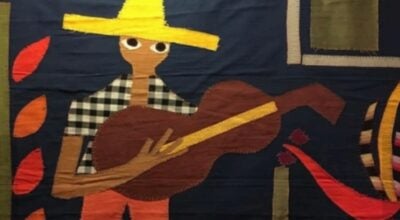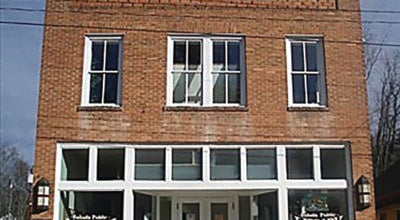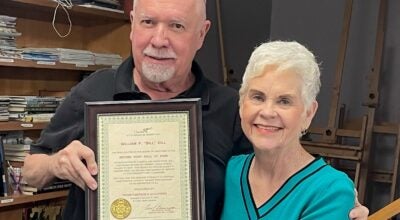Jim Shakelford sharing perspective on creation
Published 7:00 pm Tuesday, January 27, 2009
Once again I found myself walking in to meet an artist &dquo;blind.&dquo; Jeanette and Jim Shakelford welcomed me into their home to see his work before it shipped to Asheville that day for an exhibit at The First Baptist Church of Asheville. When I arrived at the house I was led down stairs and asked to face the wall until a piece of music began to play and I turn around to see an enormous swirl of blue and purple filling the wall in front of me. Jim: That&squo;s before time. That white dot is a pupil. That&squo;s what this series is about, the creation of the universe. Jeanette: It&squo;s called &dquo;Before Time.&dquo; That&squo;s when there was just void and vastness, and then the next one is the appearance of dry land. Jim: This is the spirit moving over the face of the deep. Jeanette: This last one is called &dquo;Tomorrow&dquo; and obviously people. Jim: Tomorrow is the future after the earth has been through all these reclamations projects. We have all this to look forward to. Oh my goodness, wow! Jeanette: He started this series seven years ago. He had the dreams about it eleven years ago, but started painting seven years ago. Are you from this area? There seems to be a lot of Georgia on your resume. Jim: We came here from Macon, GA. Jeanette was chair of the music department and also ran an arts program as Wesleyan College. We came here from Macon. I had traveled in this area on business many years before. When we decided to retire we got on the road and went around to all these places looking at different venues to hang out. We wound up here. I can see why. It&squo;s a nice place to be looking out through the treetops at the top of the mountain. You saw this place and decided this is where you need to be? Jim: Jeanette walked in and she said, &dquo;Oh,&dquo; and tears came in her eyes. She said, &dquo;This is it.&dquo; How long have you been here now? Jim: We came in 2001, but we didn&squo;t move full time. Jeanette: We moved here in 2002. Jim: To an artist time only means standing in front of the canvas. It doesn&squo;t matter what time of day it is, day of the month, or month of the year. You mentioned having a dream about this Creation series? Jim: This series actually started about eleven years ago. Why me, I have no idea. I&squo;m sleeping at night and having all these dreams and it went on for about three years, just about every night. At the same time though I have to say I was reading material on the universe. The origin of the universe, the origin of the stars and how all this came about as far as the scientists were concerned. After about three or four years, I actually started painting. I did not paint the series or work on the series until we had actually moved here. I did a painting called &dquo;The Plan&dquo; without thinking about a series of forty to fifty paintings or seventeen or what have you or any size. &dquo;The Plan&dquo; I just loved it. A guy came and looked at it and said, &dquo;That ought to be in New York.&dquo; The more I looked at &dquo;The Plan&dquo; the busier it got, much too busy. I gessoed &dquo;The Plan&dquo; out. “In the Beginning” acrylic on canvas by Jim Shakelford (photo submitted)Then I started really seriously thinking about a group of paintings called the Creation Series. My first painting was &dquo;In the Beginning.&dquo; This represents the force that is God creating the universe. Did you actually paint these in order? Jim: I would have a dream and the next morning I would get up and go down and paint, but I might not be happy with it and I would gesso over it and start all over. These paintings have really taken a life of their own in their own time. Jeanette: &dquo;In the Beginning&dquo; was the first one he painted, then the &dquo;Separation of Night and Day.&dquo; None of them came in any particular order, but just as the inspiration came. Jim: That really represents the light descending from above, rather than the light coming from the east from the sunrise, pushing away the darkness and evil of the world. Jeanette: Actually the presence of that light, that is the creator, is in all seventeen paintings in some way or another. Jim: The light is there, and it has to be. Is this a different method for you, creating a series? Jim: When I started this series I had no idea I would ever finish it, much less start. Jeanette: But you had done a series of lilies before. Jim: I did a series of florals for a show in Georgia, but I&squo;d never done anything along this line, never even thought about it. I was really content to paint landscapes, cityscapes, seascapes, and escapes. It was the way I was at the time. The series has changed my life. How would you say it&squo;s changed? Jim: Well, it&squo;s made me more aware of the earth. It is our duty as humankind to be stewards of the earth. I&squo;m more astute at what&squo;s good, bad, and indifferent for the earth. It&squo;s really made a big difference in my life and it might have actually calmed me down a little bit. I&squo;m a free spirit. How did you get started painting? Jim: When I was a child I did a lot of drawing on the grocery bags, the old brown bags that my folks would bring home from the grocery store. I started just drawing and diddling, I had no idea. I did one of a tiger. I really liked it. I thought maybe this is something I could do, but it didn&squo;t connect, it didn&squo;t stick with me through all these years. When I was 37 I actually started painting. I went to Sears & Roebuck and bought a box of paints and a book on how to paint landscapes. I thought, &dquo;Well I&squo;ll try this.&dquo; I did, and I have been painting ever since. Jeanette: Actually, he&squo;s been painting full time just a little over 20 years because he still had a full time day job. What were you doing up until that point? Jim: I was in the automobile and truck leasing industry working in the metropolitan area of Atlanta. I got to learn about Atlanta from the ground up. I lived there when I was a child. I learned all about the ins and outs of Atlanta. Everything coming in and going out of Atlanta is&ellip; Jim: &ellip;on a truck, or it&squo;s in a salesman&squo;s car. We leased cars and trucks. It was a great adventure. I loved every minute of it. Jeanette: He painted and worked his other job at the same time. Jim: I lost interest in that. You reached a point where your priorities about how you spent your time started to shift? Jim: Right. I&squo;d made some prints. One morning I decided I was going to go in and give it up. I put the prints in the back of my car and took off on the road to call on frame shops and galleries. I just started selling prints like that. Then I got more interested in painting than selling prints. Then I started going to the outdoor shows and selling and just loved it. Jeanette: Then you started showing in galleries and that changed your perspective about selling at outdoor shows. He was thrilled when people wanted to put his work in the galleries. Jim: I was really thrilled when people came to the gallery and paid money for my paintings. That was hard to believe. Jeanette: He doesn&squo;t do any prints anymore because he wants everything to be original art that people own. Jim: It has been a great life. What are your favorite subjects? Jim: Nature in a way is all we have to paint. There is a great line across the sky and if you follow that line it will lead you just about everywhere in painting. If you put landscapes or florals on a canvas you can see the heavens on the canvas. It would come in different styles too. I would never be able to enjoy just painting over and over one subject. I&squo;ve done a zillion paths through the woods. Jeanette: But they&squo;re all different. Jim: They are all different, but the path gets old. I have to put the path away and try a floral. I can just get wild with a painting
and it frees me up. Then I want to paint a seascape or a wooded piece. Jim then took me on a tour of his house and shared several pieces from florals to abstracts to give me a sampling of the variety of styles he has painted. Jeanette: Lots of people who come to see his work here do not understand that the same person painted all of these things. Jim says to me several times a week, &dquo;I would go crazy if I thought I had to paint in the same style, the same way all the time.&dquo; Such a variety! Do you have a schedule to your painting? Jim: I paint every day. I&squo;ve even painted today. Jeanette: All day long, most of the time to paint. Jim: I go walk up the hill which is two miles to the cul-de-sac at the top of the hill. By the time I get back I&squo;m worn out, but I shower and get down to the studio as soon as I eat breakfast and paint. Sometimes my wife will holler down, &dquo;It&squo;s time to go Jim.&dquo; Then I have to clean up and we&squo;ll go down and eat, and I&squo;ll be back in the studio probably by 1:30-2 p.m. and work till five or six, sometimes eight or nine. You get started and you stop when you realize, &dquo;I&squo;m starving to death and it&squo;s time to just stop.&dquo; In your retirement you still have a full time job. I could never retire. I could never just stop doing anything. Love to read. Read early in the morning mostly. I research. I just finished this book Art & Physics by Leonard Shlain. Jeanette: Jim feels like this book has pointed the way for him and his future in art. Jim: Every artist should read that book. It will enrich your life. He shows how the Greeks didn&squo;t have perspective in their paintings. It goes through every phase of life from the Greeks right on through to the scholars of today. It is the most amazing book I&squo;ve ever read in my life. He shows how painters figured out relativity 30 years before Einstein. All of these paintings have been researched. The first verse in Genesis I could never get through. It says &dquo;in the beginning God created the heavens and the earth.&dquo; Well in all the research I see from the scientific community it says that the universe is 10 billion years older than the earth, so there was a real conflict there for me. I had difficulty really coming to terms with that. But if you read it says &dquo;in the beginning God created the heavens&dquo; the heavens were first, &dquo;and the earth.&dquo; He put all of the materials there for the earth, but it didn&squo;t come until its turn in time. There really wasn&squo;t a conflict; it was just the way I understood it. We don&squo;t know how long a day is for an infinite being. Jim: It&squo;s difficult for people. I understand that difficulty because I went through it myself and it&squo;s real to me. In doing this series I&squo;m hoping it will enlighten somewhat and relieve people of the responsibility of thinking God created the earth in seven days of twenty-four hours. If you understand that God created the heavens and then he created the earth and everything came in turn in time then you will understand. Evolution is nothing but time. If you like and understand time as a reasonable component of your life then you will have no problem with evolution. Evolution is just a word. Jeanette: I like something Jim said to me one day, &dquo;I think evolution is the engine that God put in place to make everything happen the way he wanted it to.&dquo; I loved that word. I thought engine was a great word to use for that process. Jim: That engine is time. Jeanette: We only have to look at our grey hair to see evolution. Jim: I have evolved from a good looking guy to this old man. In time I will become an old man and in time I will die. It&squo;s that simple. What happens in between are all these little things that you do yourself to make your life happy. We were intended to be happy. It&squo;s a wonderful creation. Jeanette: We want to say something about how this came to be at First Baptist Church in Asheville. This will be the very first public showing Jim&squo;s had. It will be the first time Jim and I have seen all 17 paintings hanging at the same time. We don&squo;t have room. The most we&squo;ve had hanging are four. A family that we know who happen to own four of Jim&squo;s paintings are members of First Baptist and their senior pastor Dr. Sayles was at a dinner at their house one night and saw Jim&squo;s work and liked it and said, &dquo;Gosh I&squo;d like to know more about this man.&dquo; They said, &dquo;You would really like to know about him because he has just completed a series on the creation.&dquo; He had some ideas in mind about some things he wanted to do at First Baptist. He said, &dquo;Please have him get in touch with me.&dquo; We did and he looked at a portfolio and I think probably within a minute and a half or so he said, &dquo;This is exactly what we want for our series that we want to be doing with the arts starting in epiphany.&dquo; This was last June or so. That&squo;s how it came to be, and as we learned later they felt with the economy disintegrating and people being out of work and a climate of despair, they wanted to do something that would be uplifting to their congregation and the whole area. So they have titled this &dquo;Creation Continues,&dquo; that we are recreating things all the time and music, art, literature, dance, and theatre all have a part to play. We&squo;re just thrilled to be part of this. The really exciting thing for us on January 25 at the opening is for us to be able to see it all. I don&squo;t know if Jim told you, but he paints listening to classical music. He realized that he wanted people who came to see it to be able to have some of that same experience. That&squo;s why he wanted you to have that experience at the beginning. Jim: The music sets the tone. What music do you listen to? Jim: I listened to a lot of Mozart and Mendelssohn. Jeanette: Samuel Barber, Beethoven, Chopin, and lots of Mozart. Mozart is lively and moving as your painting. Jim: You just follow the music. Jeanette: Quite often he likes listening to the adagio and andante sections. Jim: Because I also like that peaceful calm feeling too. It makes it seem almost like there&squo;s a presence there with you. Jeanette: On the days when the church is open and people can go and see it there will be music playing that he has chosen and we have recorded for people to hear. As they wind through the 17 painting they will be hearing music. Jim: They&squo;re not just looking at a canvas as an image. It&squo;s a meaningful thing and there are so many interesting, wonderful passages in these paintings that all artists experience. There&squo;s a lady who came to visit and we showed her these paintings and as she&squo;s looking she says, &dquo;Oh, I see God.&dquo; She showed me the eyes and the nose and it is so visible. She&squo;s thinking of God as a human being in other words, because of the eyes and the facial features. It looks more like Rembrandt than God, but it was there and I had never seen it, yet it was so visible I don&squo;t know how I could miss it. “Animals Appear on Earth” acrylic on canvas by Jim Shakelford (photo submitted) It wasn&squo;t something you had intentionally put there? Jim: No, I had no idea. I did not try to pull God out of the earth. Religion and living is all a part of appreciating the earth in my opinion. It&squo;s all very much interconnected. My father was a Baptist minster and my uncle. I could never be a minister. Why is that? Jim: You see a lot of heart ache and a lot of sadness, suffering, and dying and that would be difficult for me. Jeanette: I think you are a minister with your art. Jim: That&squo;s a ministry in itself. That&squo;s the way the good Lord uses me and I don&squo;t mind being used like that, just as long as he doesn&squo;t say, &
dquo;You got to get up and start preaching.&dquo; Sometimes the words get in the way and if someone is suffering if they can just stand back and look and a piece of art and enjoy that might give them more relief from their suffering. Jeanette: I think that&squo;s what First Baptist in Asheville is trying to do with this five week series. I think they&squo;re trying to give people relief from their suffering in these hard times. Jim Shackelford&squo;s &dquo;The Creation Series&dquo; will be on display at The First Baptist Church of Asheville until February 22, 2009 Monday-Friday 8:30 a.m. to 4:30 p.m. For more information please call 828-252-4781 or visit www.fbca.net. You can find out more about Jim at his website www.jshackelfordstudios.com.





